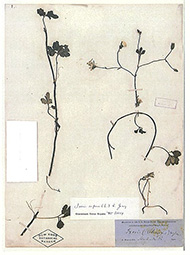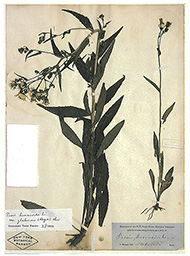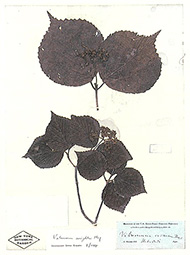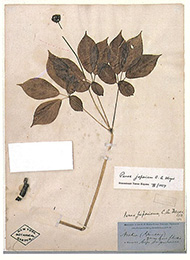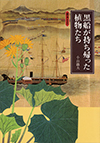- ホーム
- ネイチャーコンテンツ
- Aboc Museum
- 花の美術館
- 第19回 『黒船が持ち帰った植物たち』
- 1. 黒船による日本及びその付近での植物採集
- 2. 東アジアと北アメリカの間の植物の隔離分布について
- 3. 米国北太平洋探検隊採集の日本植物の図録
- Ⅵ 北海道とその周辺(Hokkaido and its surrounding regions)
Ⅵ 北海道とその周辺(Hokkaido and its surrounding regions)
※ 編集部注:一部抜粋して掲載します。
82 ハマニガナ(キク科)Ixeris repens (L.) A.Gray
[採集地]函館.
海岸の砂浜に生える多年草で,多く大きな群落を作る.茎は砂の中を長く横に匍い,茎のみを地上に出す.葉は三~五角状の円心形で,3~5深裂し,やや厚い.5~7月に径3cm位の頭状花序が1~3個花茎の先につく.舌状花序は黄色,総苞の長さは約1cm.
現在の函館付近は海岸砂地の消失により減少.上磯海岸,砂原海岸に稀少にみる.
[分布]熱帯から寒帯まで広く分布:日本全土,南は中国南部からインドシナまで,北は朝鮮,中国の東北からロシアのカムチャッカ半島まで生育している.
[Locality]Hakodadi. (This is Hakodate of current sense.)
[Distrib.]Widely distributed in eastern Asia from subarctic to tropical regions, growing in sandy sea shores. From Japan south to southern China and Indo-China, west to Korea and Chinese North-East and north to Kamchatka Peninsula.
83 コウゾリナ(キク科)Picris hieracioides L. subsp. japonicus (Thunb.) Krylov
[採集地]函館.
山野の草地や路傍に多い越年草で,植物全体に赤褐色の剛毛があってざらつく.茎は高さ30~80cm,多く葉を互生する.下方の葉は倒披針形,基部契形,上方の葉は倒卵形で,葉基は多少茎を抱く.茎の上部で枝分かれして,多数の頭花をつける.頭花の径は2~2.8cm,黄色の舌状花が多数ある.
母種はユーラシア大陸の北温帯に広く分布する.牧野博士はコウゾリナは顔剃り菜の意味で,植物全体がざらつくからこう名付けられたと説明している.
現在,函館近郊山野路傍にみる.
[分布]亜寒帯・温帯:日本全土,樺太.
[Locality]Hakodadi.
[Distrib.]Subarctic and temperate regions:Saghalien and all areas of Japan.
The mother species is widely spread in the boreal areas of Eurasia.
84 ミヤマガマズミ(スイカズラ科)Viburnum wrightii Miquel
[採集地]函館.
山地の林下に生える落葉低木で,幹は高さ2~3.5m,多数の枝を出す.葉は対生し,倒卵形,先は尖り,縦に尖った鋸歯がある.裏面に腺点が多く,葉脈に長い毛がある.花は5~6月に咲く.花序は数多状で,多数の花をつけ,花冠は白色で径6~7mm,5裂する.雄しべは5本.果実は赤色の核果である.
より普通のガマズミに似ているが,ガマズミの葉には多く両面に毛がある.ミヤマガマズミはガマズミより北方,またより高い所に生える. 現在,函館近郊高地にみる.横津・袴腰山地,三森山,当別丸山,恵山.
[分布]亜寒帯・温帯:北海道から九州まで,樺太の南部,朝鮮,中国.
[Locality]Hakodadi.
[Distrib.]Subarctic and temperate regions:Japan(Hokkaido to Kyushu), China, Korea and southern Saghalien.
This species closely resembles V. dilatatum, a much commoner species in Japan, but differs from it in the leaves that are glabrous above, for in the latter the leaves are densely pubescent on both surfaces. Phytogeographically, the present species is distributed more northerly than V. dilatatum, growing at higher altitudes than the latter.
85 トチバニンジン(チクセツニンジン)(ウコギ科)Panax japonica C. A. Meyer
[採集地]津軽海峡.
落葉樹林の木陰に生える多年草で,太く横に這い,有節の地下茎がある.茎の高さは花序とともに50~80cm,上部に約3枚の葉を輪生する.葉は掌状複葉で,狭楕円形の小葉が3~7枚ある.初夏から夏に茎頂に1(~4)個の散形花序をつけ,径約3mmの淡緑色の花を開く.果実は径6mmの球形,赤色に熟する.染色体数:2n=24.
広く知られた人参と同様に強壮剤にも用いるが,本種は日本では本来は去痰,鎮咳,健胃薬に用いられていた.人参即ちチョウセンニンジン(オタネニンジン)では地下に有節の根茎はなく,茎の下部に肥大した直根があり,ときに枝分かれする.人蔘の主要用途は強壮剤であり,補血,興奮の作用もある.
[分布]温帯北部・暖帯:北海道から九州(高地).
[Locality]Cape Sangar, Tousaru straight.
[Distrib.]Confined to the temperate and warm regions of Japan, from Hokkaido through Main Island to the high countries of Kyushu(rare).
Like the well-known Chinese Ginseng, this species has been used in Japan as an astringent. The Japanese original application of this species in traditional herbal medicine had, however, been for the remedy of coughing, removal of sputum and as a stomachic. The principal morphological difference between the present species and Chinese Ginseng is that the former develops a noded rhizome while the latter produces a fusiform root tuber. The principal application of the Chinese Ginseng has been as stimulant and an astrigent, or sometimes for a remedy of anemia.
『黒船が持ち帰った植物たち』コンテンツ一覧▼ 目次(青字)をクリックすると、各文をご覧いただけます
発刊に寄せて
刊行にあたって
はしがき
1.黒船による日本及びその付近での植物採集
何時,何処で,誰が?
エイサ・グレイ教授の研究
昭和天皇による黒船採集植物の御研究
Plant collecting in Japan and its adjoining territories by the Black Ships (Abstract)
2.東アジアと北アメリカの間の植物の隔離分布について
東亜と北米の間の植物の不連続分布の4型
東亜・北米間の隔離分布の由来
東亜と北米の間で隔離分布する植物の生態
隔離分布している植物の分化
Disjunct distribution of flowering plants between eastern Asia and North America (A summary account)
3.米国北太平洋探検隊採集の日本植物の図録
An annotated catalogue of plant specimens collected in Japan by the U. S. North Pacific Exploring Expeditions(1853-1855), based mainly on the set housed in The New York Botanical Garden, U.S.A.
Ⅰタイプ標本 (Type materials)
Ⅱ琉球列島 (The Ryukyus)
Ⅲ九州 (Kyushu)
Ⅳ小笠原 (The Bonin Isls.)
V下田・横浜 (Shimoda and Yokohama)
VI北海道とその周辺 (Hokkaido and its surrounding regions)
書籍詳細
-
小山鐵夫 著 B5判 / 上製 / 98頁(オールカラー) /
定価1,572円(本体1,429+税)/ ISBN4-900358-41-X
〔花の美術館〕カテゴリリンク
- 第19回 小山鐡夫追悼記念号『黒船が持ち帰った植物たち』より
- 第18回 小山鐡夫追悼記念号『植物園の話』より
- 第17回 『MAKINO 80』東京植物同好会・牧野植物同好会八十周年記念誌
- 第16回 ハマナスの語源を探る
- 第15回 金井弘夫追悼記念号『金井弘夫著作集 植物・探検・書評』より
- 第14回 『花のある風景』
- 第13回 坂嵜信之追悼記念号『日本で育つ・熱帯花木植栽事典』より
- 第12回 楽しい花観察108選『不思議な花々のなりたち』
- 第11回 川島榮生の《ヤマアジサイの世界》
- 第10回 渡辺健二『日本産ギボウシの世界』
- 第9回 『ユリノキという木』─ 魅せられた樹の博物誌
- 第8回 『北米インディアン悲詩』/ エドワード・カーティス写真集
- 第7回 江戸時代の花たち 書物に見る江戸時代の園芸文化
- 第6回 わが国初のボタニカルアーティスト 五百城文哉(いおきぶんさい)の世界
- 第5回 『ビル・ニガントゥ』 19世紀末ネパール秘蔵の本草図譜
- 第4回 植物画家 石川美枝子の作品
- 第3回 サイエンティフィック・イラストレーター 木村政司の作品
- 第2回 植物画家 中島睦子の作品
- 第1回 『PLANTAE ASIATICAE RARIORES』


